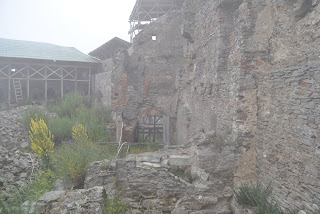Guest House, run by the Presbyterian Church, which prepared for us an abundant feast last night and this morning too.

The guest house was almost around the corner from the ruined fortress of Deva. Francis David was brought here after his condemnation as a heretic by George Biandrata, because Deva was far from Koloszvar and Torda, where the people were sympathetic to him. David died within a short time of arriving here. The fortress was ruined when its Austrian defenders during the revolution of 1848 chose to blow up its magazines rather than turn the fort over. To reach the summit of the steep, isolated hill outside of town, we took a funicular up into the clouds. (At the base was the gymnasium where Nadia Comenici and all of the other famous Romanian gymnasts trained. It made for a strange contrast.) The shattered bastions, particularly in fog and rain, seemed haunted by David's death. The cell, which the UUA persuaded the government to set aside as a monument for David, may or may not have been his actual cell, but it was the only one to survive the 1848 explosion.


In the photo, you see Z0ltan, Michael, Denisa, and Marta in front of the Francis David cell.
Next we drove to the Hunyadi castle in the city of Hunedoara. Hunedoara was a great steelmaking center under Communism, but only one of its many mills remains operational today. The castle, in fact, is surrounded by abandoned steel mills. We visited Hunyadi's grave yesterday, and his son, Matthias Corvinus, was the last seen by us mounted heroically upon a bronze steed in Kolozsvar. The castle seemed to be every little boy's idea of what a castle should look like, also it seems more like a castle out of Wagner than out of Disney. Speaking of opera, we entered the castle to the sound of a rehearsal of La Traviata in progress, which several of us sat and watched, transfixed. The castle itself was full of reminders of the brutality of the middle ages, from the isolated defensive tower (called "Don't be afraid") which could, in its day, only be reached by a rope bridge, to the 26 meter deep well dug by Turkish prisoners over fifteen years who had been promised freedom, only to be murdered instead. They left a chilling inscription in the well: "Now you have water but you have lost your soul."


From there we drove through a beautiful, hill-bordered valley up into the mountains. The fresh green landscape looked remarkably like Bavaria. We arrived in Sibiu in midafternoon and dropped Zoltan off at the railroad station to return to Gagy to prepare for our arrival on Thursday. Sibiu was one of the cities of the Saxons, brought to the Carpathians to hold off the Turks, and the German aspect of the city's architecture has survived the departure of almost all of its German speaking inhabitants. Sibiu has been named a cultural center by the United Nations, and as a result has been spruced up considerably. We enjoyed a taste of the cafe life before setting out in quest of a restaurant we had read about in our guidebook. We searched for the restaurant for quite some time before discovering that it was the very cafe we had just left. We retired to the hotel and to a beautiful sunset over the old city.




No comments:
Post a Comment